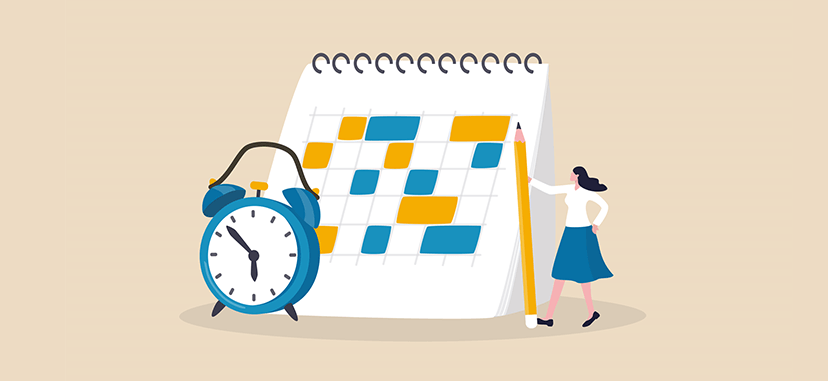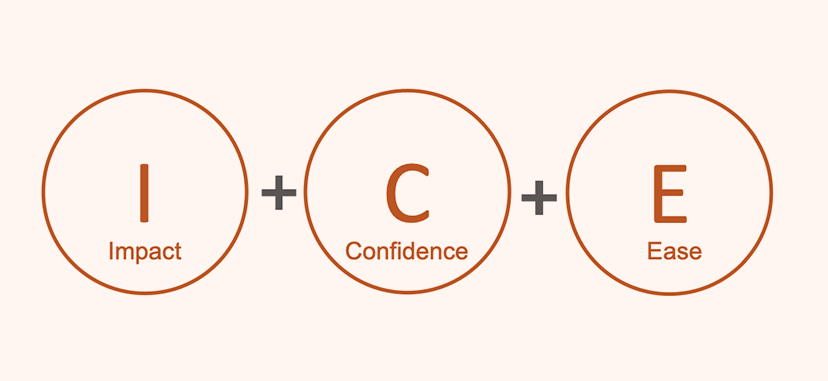
Click the button to start reading
Scary to-do list? Here’s how to prioritize tasks at work.
Let’s talk about the entrepreneur’s greatest rival. Whether scratched into a notebook or ticked off with a task management tool, almost all of us face the same problem: the to-do list that never ends. That’s because there are always new ideas for an entrepreneur or business owner! Processes that could be improved. Automations that would simplify your day-to-day or tools that would help you scale. The notion of to-do list zero is probably a pipe dream! But what is realistic is understanding how to prioritize work tasks for less stress and better outcomes.
Learning how to prioritize tasks effectively is almost as much about managing our brains as it is about project management. It requires you to learn to overcome the instinct for immediate gratification in favor of taking on the essential tasks first. Business owners have to push past procrastination with careful planning and execution. By learning to estimate the importance or urgency of projects better, you’ll be better able to make decisions.
Prioritization might also mean eliminating some tasks indefinitely when you realize they won’t get you closer to your business goals.
What we’re saying is that how to prioritize tasks best can be tough work. But by learning how to prioritize your work, you’ll also reduce your stress and improve your productivity in the long run. Well worth it if you ask us!
Here’s our step-by-step guide on how to manage projects and prioritize tasks in the workplace. Let’s get to it.

A step-by-step guide on how to prioritize tasks at work
In the steps below, we’ll walk you through everything you need to prioritize tasks at work. You’ll start with an exercise for creating an overview of all your tasks, learn how to prioritize tasks in project management using prioritization methods like the Eisenhower Decision Matrix and Eat the Frog, discover how to schedule prioritized tasks, and stay on track, and finally, figure out how to put everything you learned together for sustainable, repeatable prioritization.
1. Start by listing out all tasks
There are some important differences between a to-do list and a task list. So before you ever get to your to-dos, you’ll want to start by listing all the tasks in one big, well-organized task list. While a to-do list is more about what you plan to achieve in a set period, this list of tasks should be more comprehensive. Why? Because the very foundation of effectively managing your time and prioritizing tasks at work means having an overview of everything you want to achieve. And we mean everything.
It’s important to note that this stage isn’t about prioritizing! We’ll get to that next. Your goals for this step are just to create a comprehensive inventory of everything you’ll need to consider later.
Start by listing out categories, goals or projects. Set a timer for 15 minutes and think about what categories, goals, or projects you can define to divide your tasks best. This will become the structure of your task list, so it must be complete and well-organized before you start adding subtasks. It can be helpful to decide on a time (one month, three months, etc.) before beginning to limit the scope.
For example, a category might be “Internal Processes” or “Hire a new team member.”
If you’re getting stuck here, begin with this article on setting SMART Goals.
Get more specific. Set a longer timer for 30-45 minutes. This step helps you define what subtasks contribute to each category, goal, or project. Consider all ongoing or future tasks while you build this list. Remember that this also might include recurring daily, weekly, and monthly tasks.
You can think of “subtasks” as achievable and specific activities you can mark complete as you finish them. For example, a good subtask would be “kickoff call” or “create a one-page mockup.” “Nurture client relationship,” on the other hand, is ambiguous and hard to quantify.
Since your subtasks will become the basis for prioritization at work, really take your time here. Think through each project from start to finish, and list the subtasks necessary to help you complete it.
Adding detail. The last step in this stage is to add the necessary details to each subtask. For example, it might be helpful to know how much time a task will take to complete, the level of importance, or any major due dates when planning your priorities.
Once you’ve completed this step, you should have a complete overview of your goals or projects; all that needs to be done, along with any relevant information you’ll need as you decide to prioritize, delay, or eliminate a task.
Ready to move on?

2. Define your priorities using prioritization methods
Now that you have a complete task list, it’s time to start prioritizing. But there’s no need to shoot in the dark here. Dozens of time-tested productivity frameworks and methods have been shown to improve productivity and output.
Using a framework gives you a clear structure to follow in prioritizing your tasks. It can also result in higher-quality outcomes, reduced busy work, faster development, and closing expectation gaps by creating more realistic estimates.
The best productivity method for you or your team will depend on various factors and might need to be tested with trial and error, but we’ll walk you through a few of our favorites.
The Eisenhower Decision Matrix or the Urgent-Important Matrix
The Eisenhower Decision Matrix (also called the Urgent-Important Matrix) is a matrix that allows you to rank tasks on a matrix where the axes are urgency and importance. This technique was popularly used by the 34th US President – Dwight D. Eisenhower – to make difficult decisions. By using the Eisenhower Decision Matrix, all tasks can be placed on the matrix and fall into one of four categories:
Tasks that are urgent and important = do first. These are the big ones. Things that are urgent (time sensitive) or important (valuable to your business, high-impact for low effort, essential for ongoing operations, etc.). When using the Eisenhower Decision Matrix, you’ll aim to complete any tasks in this category first.
Tasks that are important but not urgent = schedule. As previously described, you should always make time for items important to your business. However, if they’re not urgent, this matrix advises that you schedule these tasks. Choose a realistic timeframe or deadline to ensure these tasks are completed on time.
Tasks that are urgent but not important = delegate. One of the most important things a leader can learn is when to delegate. The Eisenhower Decision Matrix advises that tasks due soon but of low value or importance to the business should be delegated. This might mean hiring it out or giving it to someone on your team to complete so you can shift your focus back to the high-importance tasks.
Tasks that are not urgent or important = eliminate. According to this matrix, tasks that are neither urgent nor important should be eliminated or postponed. Now, you might be wondering – why is anything unimportant or not urgent on a task list? You might be surprised at how many things fall into this category. This is another argument for carefully assessing your categories and goals before completing your list. Make sure that all the subtasks on your list will ultimately contribute to your company’s success or are essential for doing business to make the most of your finite time and energy.

Eat the Frog
Eat the frog is a productivity method that suggests identifying your “frog” – the hardest, most important task for the day – and doing it before moving on to the rest of your list. By finishing the job in the morning, the idea is that you eliminate stress or the risk that the task won’t get completed because you put it first. And you do this every day.
This technique is based on the Mark Twain quote: “If it’s your job to eat a frog, it’s best to do it first thing in the morning. And if it’s your job to eat two frogs, it’s best to eat the biggest one first.”
And here’s why it works: by choosing ONE focus for the day, you promote deep focus, get specific about your goals, and take advantage of the period when you have the most energy for the task.
Before you try “Eating the Frog,” here are some tips to keep in mind:
- Choose your frog. This is often an important but non-urgent task that you find yourself resisting. It should be specific and clearly defined. It can also be helpful to choose your frog the night before so you can hit the ground running in the morning.
- Make it achievable in 1-4 hours. Since you have way more to do in a day than one big task, choosing a task you can finish in 1-4 hours (or half a workday) is best. If your “frog” is a bigger task, break it into subtasks you can finish in this block. You’ll benefit from completing a daunting task before moving on to your other tasks for the day.

RICE
RICE is a prioritization method that stands for reach, impact, confidence, and effort.
To start, you evaluate the reach of a task. How many people or events will be effected?
The next step is evaluating impact. How much does the task contribute to the overall goal? This should be quantified using the following scale:
- 3 for the biggest impact
- 2 for high impact
- 1 for medium impact
- 0.5 for low impact
- 0.25 for minimal impact
Now it’s time to assess confidence. How confident are you about the impact of the task? What’s the likelihood it’s as important or valuable as you think? To quantify this, use a multiple choice scale: 100% is high confidence, 80% is medium, and 50% is low.
Finally, how much effort is required? This is how much time and resources a project takes, calculated with “people * months.” For example, a project that takes a month and one team member could be 1*5 (lower effort), while a task that takes a couple of days and 3 team members could be 3*2 (higher effort)
Once you’ve set all the variables, you can apply the formula:
RICE = (Reach * Impact * Confident) / Effort
This framework can be beneficial for project managers trying to consider multiple factors when resource planning.

ICE Scoring Model
Like RICE, the ICE Scoring Model considers a project’s impact, Confidence, and Ease of a project when determining its priority.
Impact considers how much the task will affect one key metric. Confidence is the certainty that the project will produce the expected impact. And ease is based on effort.
However, the formula looks a bit different than RICE. Each item is ranked on a scale of 1-10 for each of the 3 values. Then, those numbers are multiplied to determine an ICE Score.
Since the values are equally weighted, the formula is easy-to-use and can clearly indicate how important a project is. But since it’s subjective, there might be better methods for large teams with complicated variables.
Chunking
Chunking is a technique that helps limit multitasking and manage procrastination by grouping tasks into manageable chunks which can be done in order.
Practically speaking, this means dividing working hours into blocks dedicated to a specific purpose. It’s best to go as far as blocking times in your schedule to complete the tasks and avoid distractions during that time.
Here are a few tips for chunking to be effective:
- One task at a time. Rather than using your chunks to toggle between tasks, stick to one task at a time. This allows for deeper focus and less distraction.
- Honor your time blocks. When you have time on the calendar for a set task, stick to them. Rather than getting pulled into other jobs or getting distracted, set yourself up for success by turning off notifications, setting a timer, charging up your laptop, or doing whatever else is needed to stay focused.
- Review and repeat. After you’ve started with chunking, take some time to review your results. Has it been working for you or your team? Do you need to shift the time you allocate to a given project? Review as necessary, and repeat.

The Hundred Dollar Method
The Hundred Dollar Method – also called the Hundred Dollar Test – is a method for prioritizing, considering the input of many stakeholders.
Here’s how it works: each stakeholder gets “one hundred dollars” – you can think of this as points allowing each user to vote towards features or priorities. Once everyone allocates their hundred points, you’ll have a more comprehensive view of which tasks are considered a priority by everyone involved.
This technique is good in that it considers the input of diverse stakeholders and forces each person to prioritize, understanding there are limited resources. It can also be combined with MoSCoW Prioritization (more on that below), where tasks are prioritized into groups based on how many total points they receive.
ABCDE method.
The ABCDE method uses the alphabet’s first letters to quantify the importance of your tasks.
To apply it, you’ll go through your task list and assign a letter value to each task according to its level of importance, with A tasks being top priority and E tasks being low priority.
Limit your A tasks to three tasks, and then prioritize those tasks before moving on to B tasks. You’ll then complete B tasks before moving on to C tasks, etc.
The ABCDE method is beneficial because of its simplicity and can easily be combined with “eat the frog” to manage your to-do list.
MoSCoW Prioritization
MoSCoW stands for “must have, should have, could have, and won’t have.” Like the Eisenhower Decision Matrix, it challenges you to place tasks into one of these four categories.
- Must have are the most critical requirements, features, or tasks in a project.
- Should have are requirements that are important but not urgent.
- Could have are beneficial things, but that won’t cause damage if they’re skipped
- Won’t have are tasks you can eliminate for now or implement later.
The MoSCoW Prioritization is helpful for its simplicity and agility and is best used on small tasks or projects.
Other prioritization techniques
This list has only scratched the surface of prioritization and project management techniques. Want to learn more? You might also check out the Kano Model, Story Mapping, and other techniques to determine what works best for your organization.

3. Scheduling tasks and other tips for success
With your list created and your priorities in place, it’s time to move on to implementing your priorities and staying on track. Here are a few of our tips on how to prioritize tasks at work with the help of scheduling.
When and how often to prioritize tasks at work?
Effective prioritization requires regularly evaluating your priorities as your projects and goals change.You might introduce a daily, weekly, or monthly practice for setting big-picture priorities, but you might prioritize daily for smaller projects.
For example – you might have a monthly calendar event where you reevaluate your categories, goals, or take inventory of your projects. You could create a to-do list every week, built around your priorities. And each day, you might order your most urgent or important tasks based on what you can realistically achieve. Anything that doesn’t get finished then gets put to the top of the list for the next day.
Creating your to-do list
Your prioritized task list will become the basis for your to-do list. Rather than a list of aspirations, ideas, and do-somedays, aim to create a to-do list with daily tasks based on your priorities. Some aspects of a good to-do list are that tasks are…
- Specific. Everything on your to-do list should be specific. Audit your to-do list and add detail on anything that’s not crystal clear. Your to-do list should be action-oriented rather than aspirational.
- Achievable. Another critical difference between a to-do list and your task list with goals and long-term projects is that it should be achievable. Rather than listing ongoing tasks, break them out further into action items. Be sure to set realistic time estimates and honestly assess what you can realistically finish in a fixed period when creating yours.
You might have a to-do list that you create daily or weekly. What’s important is that it offers a clear overview of everything that needs to be done and provides detail on their priority level.
Schedule it in
Once you understand your to-do list, the best way to achieve it is to schedule time for each of the tasks and stick to it. This doesn’t just mean setting deadlines or a goal to finish something “by the end of the week.” Instead, you might benefit from Timeboxing, where you create a dedicated time to complete a task. This ensures that you realistically evaluate how much time a project will take and notice when you’re getting off schedule so you can reprioritize as you go.
Still need some guidance? More on the advantages of project scheduling.

4. Putting it all together
Now, you’ve created a task list, prioritized tasks, and made a schedule to help you finish everything. The last thing we want to talk about is putting it all together. This means not just doing the groundwork but staying consistent and following through to reach better outcomes.
Complete tasks when you say you will.
The importance of accountability – to yourself and others – is a vital part of prioritization. Whenever we create a to-do list or task list that is unrealistic, unclear, or otherwise unachievable, we break trust in ourselves. We signal to our brain that deadlines are flexible or reinforce negative beliefs that we will, in fact, “never get it all done.”
So completing tasks when you say you will is more than just a productivity goal. Instead, you can think of this as a practice that will help you build accountability with yourself and create a pathway to more productivity. Here are some ideas about how you can build accountability and trust into your culture.
Keep others updated.
We are only human, so there will still be times when we experience delays, or things take longer than we think they will. On the other hand, sometimes, we could finish things early or need fewer resources than expected.
The key here is communication! Make updating others part of your new prioritization process. This is especially important when working remotely or asynchronously. Whether it’s blocking some time each week to email clients about the status of their project or introducing a project management tool that notifies team members when a task is ready to be taken over, this helps keep everyone on the same page and projects moving ahead smoothly.
Notice resistance, and push through.
Prioritization goes against our human instinct for quick wins. Our brains prefer delaying essential tasks for the immediate satisfaction of easy ones! So to learn how to prioritize tasks at work, we need to rewire our reward system.
Do your best to create a plan that you can stick to. Rather than jumping between methods or techniques or reverting to old inefficiencies, commit to trying something for a set period before deciding whether it works. Change is always a struggle, so anticipate that these new methods might be hard and commit to trying anyway.
Stay adaptable and reprioritize as needed.
That said, being successful always requires staying flexible and open to change. After trying a prioritization technique or doing it routinely, take stock of what’s working and what’s not.
Reviewing priorities regularly gives you a chance to improve and realign as needed for the best possible outcome.
















